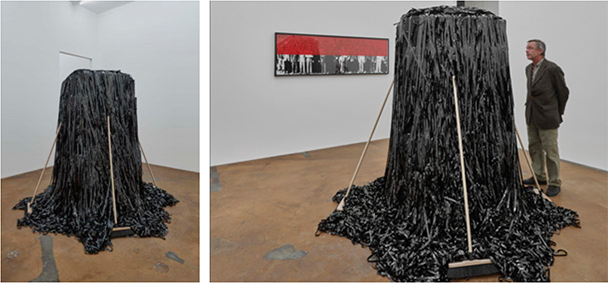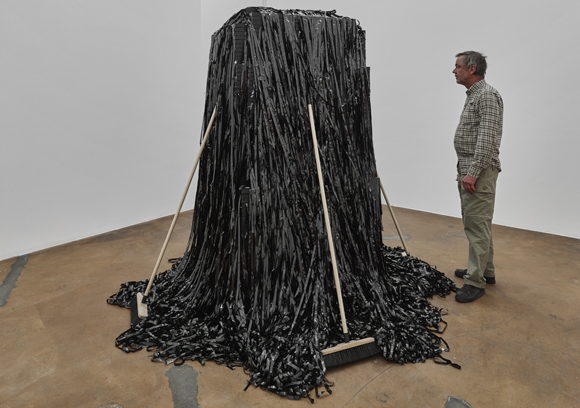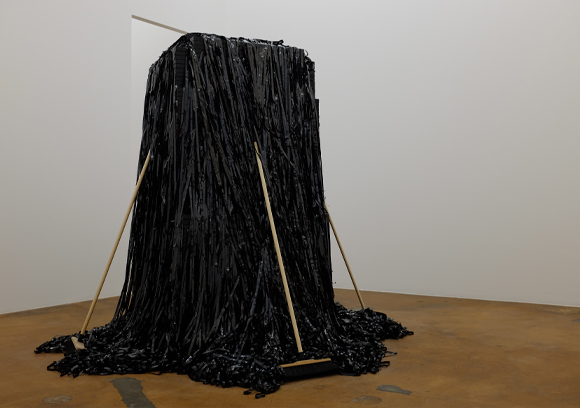| |
|
|
39.
| Dark Memory |
| |


2014-2015, VHS, tapes, brooms, 190 x 120 x 110 cm.
Exhibition view from Permanent Exiles, Mamco, Geneva, 2015.
Courtesy of the artist and Ceysson & Bénétière, Paris.
'' The Dark Memory installation refers to a dark past that becomes inaccessible in the absence of a VCR player. ''
Studio Fatmi, May 2015

Dark Memory
Exhibition view from Permanent Exiles, Mamco, Geneva, 2015

Dark Memory
Exhibition view from Permanent Exiles, Mamco, Geneva, 2015
|
|
|
|
|
|
Dark Memory est une installation composée de cassettes VHS empilées et recouvertes de pellicules noires. Telle une marée noire se répandant en cascade de cette structure architecturale, la pellicule est retenue à la base des quatre faces par des balais. Ces quatre balais, objets quotidiens de nettoyage et de traitements des déchets, font figures de gardiens, de nettoyeurs de mémoire. Ex-voto de la société de consommation, l’installation Dark Memory renferme des images d’un passé sombre devenu illisibles en l’absence de magnétoscope.
La cassette VHS, symbole par excellence à notre époque de l’obsolescence technologique, est ici à la fois accumulée et dissimulée. Cet objet, finalement voué à disparaître, se trouve mise en scène comme élément d’architecte d’un temple recélant une mémoire sale. Si la cassette VHS a été pour une génération l’objet incarnant l’espace du souvenir gravé pour ce qu’on a cru l’éternité, l’installation Dark Memory questionne le rapport aux images et aux souvenirs. L’image de la cassette VHS élément par excellence de la copie s’est vue dépassée par une image numérique où la copie et l’originale ne font qu’un. Plus d’effet de détérioration et de perte de qualité, la révolution de l’image numérique a effacé complètement toute une imagerie de notre mémoire collective.
Le public est ici invité à se confronter à cette data base renfermant des souvenirs et images personnelles ou relevant de la mémoire collective. Laissant une large part au libre arbitre et l’appréhension de chacun, l’installation Dark Memory, donne la possibilité de cacher ou de tenter d’oublier. Par l’accumulation de cassette VHS, l’artiste réactive sa réflexion sur la lecture des images médiatiques et leurs réceptions. La mémoire, le passé, la négation, la reconstruction, mounir fatmi ne cesse de buter, de se retourner et d’interroger sa propre mémoire comme l’histoire du monde.
Studio Fatmi, Mai 2015.
|
|
Dark Memory is an installation composed of VHS cassettes stacked and covered with black film reels. A black tide flowing like a cascade over this architectural structure, the film reel is held at the four corners of its base by brooms. These four brooms, every day objects used for cleaning and waste removal, act as guardians and memory cleansers. An ex-voto of the consumer society, the Dark Memory installation refers to a dark past that becomes inaccessible in the absence of a VCR.
The VHS cassette, a symbol of technological obsolescence in today’s day and age, here is both accumulated and concealed. This object, destined to ultimately disappear, is staged as an architectural element of a temple concealing a begrimed memory. While the VHS cassette was for a generation that believed that the memory engraved on the object would be eternal, the Dark Memory installation questions the relationship between images and memories. The image of the VHS, a representation of a copy, has been surpassed by a digital image in which the copy and the original are one in the same. With no more deterioration or loss of quality, the digital image revolution has completely erased an entire depiction of our collective memory.
The public is invited to confront this database containing memories and personal images belonging to the collective memory. Leaving a large part to each person’s free will and apprehension, the Dark Memory installation offers the opportunity to hide or to try to forget. Through the accumulation of VHS cassettes, the artist revives his rumination on the analysis and reception of media images. Memory, the past, negation, and reconstruction are ceaselessly questioned and examined by mounir fatmi, as are his own memories and the history of the world itself.
Studio Fatmi, May 2015.
Traduit du français par Christina Washington.
|
|
|
|